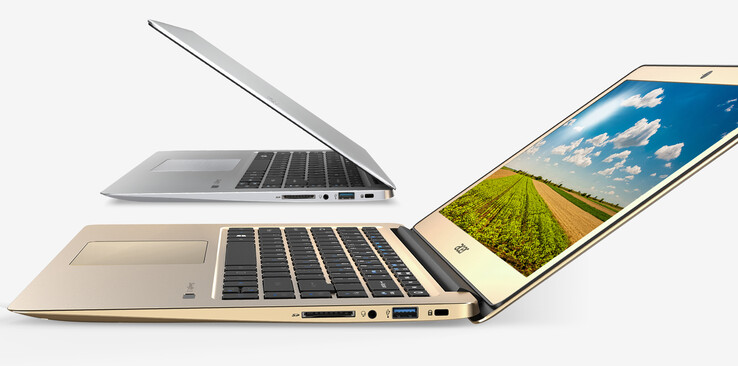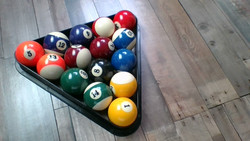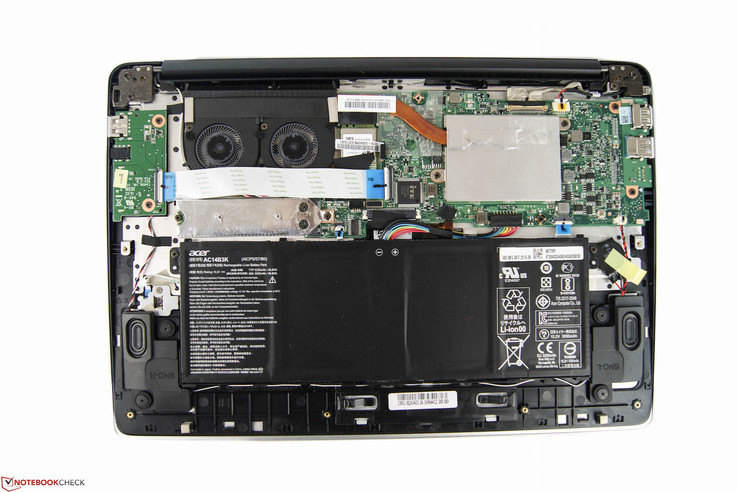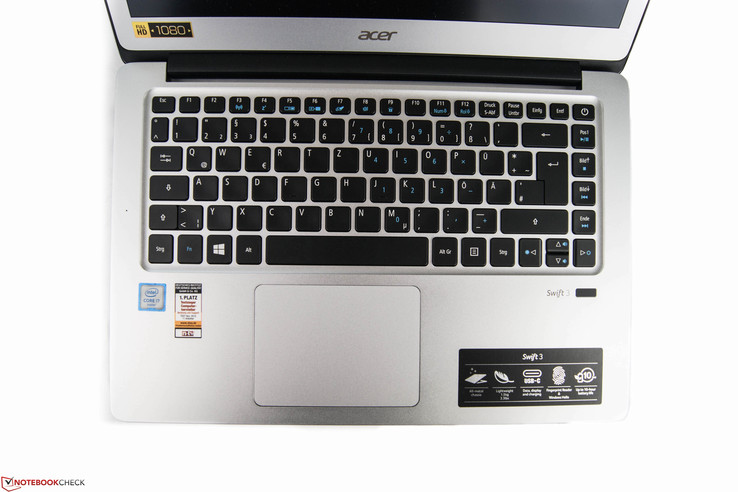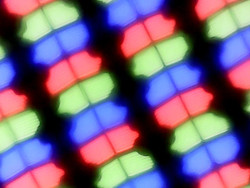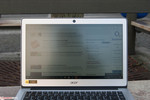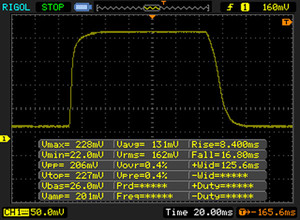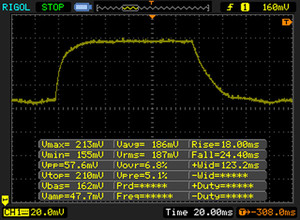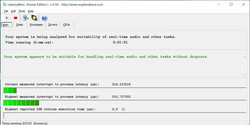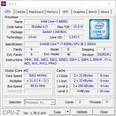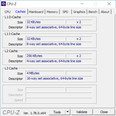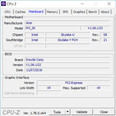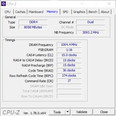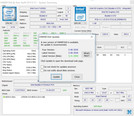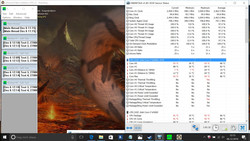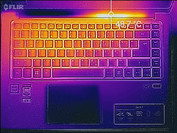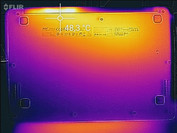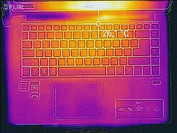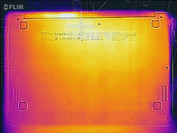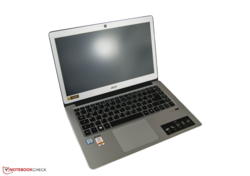Acer Swift 3 SF314-51-731X Notebook Review

For the original German review, see here.
Acer presented its new Swift series for the first time at IFA 2016. Our test model of the Swift 3 is a subnotebook equipped for everyday applications, which is supported by the aluminum chassis and the decent hardware equipment. The latter includes an Intel Core i7 processor from the Skylake generation, a Full HD panel, 8 GB of RAM as well as a large 512 GB SSD. Acer sells the Swift 3 for just under 1000 Euros (~$1038), but there are also less expensive SKUs with smaller storage capacities and slower CPUs. The entry-level version currently starts at 600 Euros (~$623).
There are numerous comparison devices in the subnotebook segment, including the slightly more expensive (+100 Euros) Asus ZenBook UX330UA with similar components. There are also alternatives from Acer: The Acer Aspire S 13 with the same specifications and a good overall rating was convincing in our review. There is also the slightly more expensive Acer TravelMate X3, which also works as a business device. Looking for more GPU performance? The Lenovo IdeaPad 500s for 1000 Euros (~$1038) is an interesting alternative with a dedicated Nvidia GPU. Finally, we want to mention the Dell XPS 13, which got a very good rating. It is 550 Euros (~$571) more expensive, but is a good comparison with a higher class of devices.
Case
Acer uses a high-quality aluminum chassis (silver) for the Swift 3. As well as the silver and matte finish, you can also choose a golden model. Our test model leaves a very sophisticated impression at a first glance. All edges are carefully rounded and the individual case elements fit very well together. The display hinge offers a convenient resistance, but we had to use both hands to open the lid of the 14-inch notebook. The chassis is quite stable, even though you can dent the lid slightly with some pressure. Maintenance work or replacing the battery will require the removal of the entire bottom panel. This process is quite complicated due to numerous plastic clips and therefore only recommended for experienced users. After the removal of the panel, you can access the battery, the CMOS battery and the SSD. It is also possible to clean the fans.
The Swift 3 tips the scale at around 1.55 kg (~3.4 lb). Subjectively, the 14-inch system is a convenient travel companion. If you prefer a lighter device, but do not want to switch to a plastic chassis, the Asus ZenBook with a weight of just 1.2 kg (~2.6 lb) is worth a look. The height of 13.5 mm (~0.5 in) is also 4.5 mm (~0.2 in) lower compared to our model. For comparison: The TravelMate X3 has pretty much the same dimensions as our model. One interesting aspect is the similar weight of the Lenovo IdeaPad 500s, despite a dedicated GPU. However, it is slightly thicker at 19.5 mm (~0.8 in) and does not feature a metal chassis.
Connectivity
We can find the essential ports on the new Swift 3, but the USB 3.1 Type-C port deserves praise.
However, it is rather unfortunate that only one of the two USB Type-A ports supports the faster 3.0 standard. All ports are located in the rear areas of the sides, so there should not be any issues with attached cables on the desk.
SD Card Reader
You have to expect surprisingly long waiting times if you plan to transfer pictures onto your notebook via an SD card. We only determined transfer rates of 22.7 MB/s when we copied JPEG files (around 5 MB each) from our reference card, Toshiba Exceria Pro SDXC 64 GB UHS-II. We are already familiar with similarly low values from the Acer TravelMate X3, and the Asus ZenBook is not much better at around 30 MB/s. If you have to rely on this scenario on a regular basis, you should consider competitors such as the Dell XPS 13.
| SD Card Reader | |
| average JPG Copy Test (av. of 3 runs) | |
| Acer Aspire S 13 S5-371-71QZ | |
| Lenovo Ideapad 500s-14ISK | |
| Asus Zenbook UX330UA-FC059T | |
| Acer Swift 3 SF314-51-731X | |
| Acer TravelMate X3 X349-M-7261 | |
| maximum AS SSD Seq Read Test (1GB) | |
| Lenovo Ideapad 500s-14ISK | |
| Acer Aspire S 13 S5-371-71QZ | |
| Asus Zenbook UX330UA-FC059T | |
| Acer Swift 3 SF314-51-731X | |
| Acer TravelMate X3 X349-M-7261 | |
Communication
Almost all notebooks in this comparison are limited to wireless Internet connections via a WLAN module. Our test model is equipped with the Qualcomm Atheros QCA6174 802.11ac module with 2x2-MU-MIMO support. According to the specifications, it can manage transfer rates of up to 866 Mbps (gross). We can only measure shockingly low speeds of around 115 Mbps via iperf (Server & Client). The Asus ZenBook (also with MIMO 2x2 technology) manages 5 to 6 times higher transfer rates. The much more expensive Dell XPS 13 is also much better at around 580 Mbps (Server) and 461 Mbps (Client).
Ethernet connections can only be established via USB adapter. This is not the case for the Lenovo IdeaPad 500s though, where the wired networks can be accessed via an Ethernet port.
A 1.3 MP webcam is integrated for video calls. It provides usable pictures in daylight, but you can always see picture noise. The latter is more pronounced in darker environments.
| Networking | |
| iperf Server (receive) TCP 1 m (sort by value) | |
| Acer Swift 3 SF314-51-731X (jseb) | |
| Asus Zenbook UX330UA-FC059T | |
| Acer Aspire S 13 S5-371-71QZ | |
| Acer TravelMate X3 X349-M-7261 (jseb) | |
| Dell XPS 13 2016 9350 (FHD, i7-6560U) | |
| iperf Client (transmit) TCP 1 m (sort by value) | |
| Acer Swift 3 SF314-51-731X (jseb) | |
| Asus Zenbook UX330UA-FC059T (jseb) | |
| Acer Aspire S 13 S5-371-71QZ | |
| Acer TravelMate X3 X349-M-7261 (jseb) | |
| Dell XPS 13 2016 9350 (FHD, i7-6560U) | |
Security
Our test model is not defined by the numerous security standards, which are more important for business devices. However, there are still some security features available, including a TP module 2.0 as well as a fingerprint scanner. The swipe-style fingerprint scanner unlocks the device quickly and without any problems.
Accessories
The included accessories are limited to a brochure and a short setup guide. The manufacturer does not list any dedicated accessories for this system on its website.
Maintenance
You will have to remove the entire bottom panel of the Swift 3 if you want to carry out any maintenance work on it. After the removal of all the surrounding screws, you have to lift the bottom panel very carefully, because it is also secured with plastic clips. You should use a sharp object. Once the bottom is lifted, you can perform essential repair works. You can gain access to most components, but the memory is soldered and therefore cannot be replaced or upgraded. Potential purchasers of the i3 version in particular should be aware of this since it is equipped with just 4 GB of RAM, which cannot be upgraded retrospectively.
Warranty
Acer offers a 24-month warranty by default. It includes a Pickup & Return service as well as an international traveller's warranty for one year. More information is available in the provided service manual.
Please see our Guarantees, Return Policies & Warranties FAQ for country-specific information.
Input Devices
Keyboard
Acer uses a black chiclet keyboard with a one-stage background illumination, so you can also type comfortably in dark environments. The key travel is good for a notebook and a medium-hard pressure point, so ten-finger typists will enjoy the input. The positioning of the Page up/Page down on the right side is rather unusual due to the small distance between the Shift and the adjacent key. The vertical directional keys are also smaller (half size). Overall, the Acer Swift 3 is also suitable for prolonged office work.
Touchpad
The touchpad (7.7 x 10.6 cm/~3 x 4.2 in) leaves a good impression as well. Inputs are executed quickly and multi-touch gestures are no problem. Even inputs in the corners are recognized easily. Multi-touch gestures work surprisingly well; we can only criticize the buttons underneath the pad. The travel differs noticeably between the edges and the center. The clicking sound is not too loud, but rather tinny.
Display
Acer uses a Full HD display from AU Optronics in the notebook. It is a high-quality matte panel to prevent reflections and the 14-inch screen is based on the IPS technology. However, unfortunately, the average luminance of 208 nits is low. That this is not necessary is shown by the Acer Aspire S13, where we determined almost 360 nits in the center. On the other hand, positive aspects include a good brightness distribution of 91% and the lack of backlight bleeding or clouding, respectively. Acer equips all Swift 3 models with an IPS screen, so we can assume it is the same panel. Unfortunately, no other options are available.
| |||||||||||||||||||||||||
Brightness Distribution: 91 %
Center on Battery: 215 cd/m²
Contrast: 694:1 (Black: 0.31 cd/m²)
ΔE ColorChecker Calman: 5.6 | ∀{0.5-29.43 Ø4.79}
ΔE Greyscale Calman: 4.2 | ∀{0.09-98 Ø5}
55% sRGB (Argyll 1.6.3 3D)
35% AdobeRGB 1998 (Argyll 1.6.3 3D)
37.81% AdobeRGB 1998 (Argyll 3D)
55% sRGB (Argyll 3D)
36.59% Display P3 (Argyll 3D)
Gamma: 2.46
CCT: 6564 K
| Acer Swift 3 SF314-51-731X AU Optronics AUO213D B140HAN02.1, , 1920x1080, 14" | Dell XPS 13 2016 9350 (FHD, i7-6560U) Sharp SHP1449 LQ133M1, , 1920x1080, 13.3" | Asus Zenbook UX330UA-FC059T AU Optronics AUO272D / B133HAN02.7, , 1920x1080, 13.3" | Acer Aspire S 13 S5-371-71QZ AUO B133HAN04.1, , 1920x1080, 13.3" | Acer TravelMate X3 X349-M-7261 AU Optronics B140HAN02.1, , 1920x1080, 14" | Lenovo Ideapad 500s-14ISK Chi Mei CMN14A7, , 1920x1080, 14" | |
|---|---|---|---|---|---|---|
| Display | 50% | 71% | 1% | 11% | ||
| Display P3 Coverage (%) | 36.59 | 54.8 50% | 64.2 75% | 36.97 1% | 40.74 11% | |
| sRGB Coverage (%) | 55 | 82.3 50% | 90.6 65% | 55.6 1% | 60.6 10% | |
| AdobeRGB 1998 Coverage (%) | 37.81 | 56.6 50% | 65.3 73% | 38.2 1% | 42.15 11% | |
| Response Times | -3% | 10% | -21% | -9% | 1% | |
| Response Time Grey 50% / Grey 80% * (ms) | 42 ? | 42.8 ? -2% | 32 ? 24% | 50 ? -19% | 42 ? -0% | 43 ? -2% |
| Response Time Black / White * (ms) | 24 ? | 24.8 ? -3% | 25 ? -4% | 29.6 ? -23% | 28 ? -17% | 23 ? 4% |
| PWM Frequency (Hz) | 200 ? | |||||
| Screen | 60% | 40% | 33% | 15% | -27% | |
| Brightness middle (cd/m²) | 215 | 385 79% | 360 67% | 375 74% | 230 7% | 249 16% |
| Brightness (cd/m²) | 208 | 350 68% | 337 62% | 358 72% | 226 9% | 235 13% |
| Brightness Distribution (%) | 91 | 86 -5% | 86 -5% | 87 -4% | 86 -5% | 87 -4% |
| Black Level * (cd/m²) | 0.31 | 0.17 45% | 0.22 29% | 0.39 -26% | 0.2 35% | 0.44 -42% |
| Contrast (:1) | 694 | 2265 226% | 1636 136% | 962 39% | 1150 66% | 566 -18% |
| Colorchecker dE 2000 * | 5.6 | 4.17 26% | 5.21 7% | 4.6 18% | 5.07 9% | 9.47 -69% |
| Colorchecker dE 2000 max. * | 11.29 | 7.61 33% | 8.85 22% | 8.8 22% | 10.07 11% | 15.41 -36% |
| Greyscale dE 2000 * | 4.2 | 5.39 -28% | 6.23 -48% | 4 5% | 3.64 13% | 10.22 -143% |
| Gamma | 2.46 89% | 2.12 104% | 2.5 88% | 2.34 94% | 2.46 89% | 2.34 94% |
| CCT | 6564 99% | 7404 88% | 6506 100% | 7304 89% | 6521 100% | 11451 57% |
| Color Space (Percent of AdobeRGB 1998) (%) | 35 | 62.7 79% | 59 69% | 57.9 65% | 35 0% | 39 11% |
| Color Space (Percent of sRGB) (%) | 55 | 99.8 81% | 90 64% | 88.7 61% | 55 0% | 57 4% |
| Total Average (Program / Settings) | 36% /
50% | 40% /
42% | 6% /
24% | 2% /
9% | -5% /
-16% |
* ... smaller is better
We can measure an average and sufficient contrast ratio of 649:1. This means that you cannot expect really rich blacks. The clear leader in this respect is once again the Dell XPS 13, which manages a contrast ratio of 2265:1 followed by the Asus ZenBook at 1636:1.
Our test laptop is not suitable for professional graphics editing, which is clear when we look at the color space coverages. Our measurements determined 55% sRGB and just 35% AdobeRGB.
The analysis of the deviations of the colors and the grayscale shows decent results, which is typical for an IPS panel. The DeltaE deviations for the colors are 5.6 and 4.2 for the grayscale.
Display Response Times
| ↔ Response Time Black to White | ||
|---|---|---|
| 24 ms ... rise ↗ and fall ↘ combined | ↗ 8 ms rise | |
| ↘ 16 ms fall | ||
| The screen shows good response rates in our tests, but may be too slow for competitive gamers. In comparison, all tested devices range from 0.1 (minimum) to 240 (maximum) ms. » 53 % of all devices are better. This means that the measured response time is worse than the average of all tested devices (20.3 ms). | ||
| ↔ Response Time 50% Grey to 80% Grey | ||
| 42 ms ... rise ↗ and fall ↘ combined | ↗ 18 ms rise | |
| ↘ 24 ms fall | ||
| The screen shows slow response rates in our tests and will be unsatisfactory for gamers. In comparison, all tested devices range from 0.165 (minimum) to 636 (maximum) ms. » 66 % of all devices are better. This means that the measured response time is worse than the average of all tested devices (31.7 ms). | ||
Screen Flickering / PWM (Pulse-Width Modulation)
| Screen flickering / PWM not detected | ||
In comparison: 53 % of all tested devices do not use PWM to dim the display. If PWM was detected, an average of 8152 (minimum: 5 - maximum: 343500) Hz was measured. | ||
Very wide viewing angles are another advantage of the IPS technology. This means that you can look at the screen from the side without any color deviations or brightness decrease.
The opening angle of the screen is more than 180 degrees, which is sufficient to use the device on the lap.
Performance
Our test model is the high-end version from the Swift 3 lineup. Thanks to an Intel Core i7 processor, a 512 GB SSD and 8 GB of memory, the 14-inch device is suitably equipped for office and multimedia tasks. There is even some headroom for more demanding applications. If you plan to spend less money, you can choose between two other models: one Core i3 version with only 4 GB of RAM (not expandable), the entry-level model for 600 Euros (~$623) that has only a 128 GB SSD. Another option is the Intel Core i5 version, which includes 8 GB of RAM. Depending on your wallet, you can choose between a 256 and 512 GB SSD.
Processor
The heart inside the test model is an Intel Core i7-6500U. It is a dual-core chip with clocks between 2.5 and 3.1 GHz (two cores up to 3.0 GHz). Because of the low power consumption of 15 watts (TDP according to the manufacturer), the CPU is mainly used in slim notebooks and ultrabooks. Based on the Skylake architecture, the CPU is not part of Intel's brand-new Kaby Lake generation. The difference compared to the Kaby Lake successor Intel Core i7-7500U is about 10%, but the CPU of the test model still provides plenty of performance for complex software. We use the Cinebench R15 benchmarks to determine the real performance and compare the results with the rivals. The Multi-Core test determines 323 points, which is really good and in the upper third of all devices we have reviewed with this CPU. All the rivals are on a very similar performance level except for the Acer Aspire S 13. Even though the latter is also equipped with the Intel Core i7-6500U, it does not even reach 300 points.
It is possible to utilize the full CPU performance of the Swift 3 on battery power. The Cinebench R15 score is similar without the attached power adapter.
The performance difference compared to other processors can also be quite interesting. We recommend our dedicated article on benchmarks for modern notebook processors.
System Performance
The combination works! A responsive SSD together with a powerful Intel Core i7 CPU supported by memory in a dual-channel configuration. In short: We like working with the laptop. We use PCMark 8 to check our subjective impression. The results are scores of almost 4400 points in the Work test and 3500 points in the Home test. A look at the competition shows that the Swift 3 can easily compete with their results and therefore confirm our impression.
| PCMark 8 Home Score Accelerated v2 | 3503 points | |
| PCMark 8 Work Score Accelerated v2 | 4385 points | |
Help | ||
Storage Devices
The storage solution is a solid-state disk from LiteOn's CV 3 series. As described in the maintenance section, it is an M.2 drive with a capacity between 128 GB and 512 GB depending on the model. We can check the largest drive in our configuration.
The sequential transfer rates show the expected performance for a SATA 3.1 interface. Only the writing performance of 398 MB/s could be slightly higher for our taste.
| Acer Swift 3 SF314-51-731X Liteonit CV3-8D512 | Asus Zenbook UX330UA-FC059T SanDisk SD8SNAT256G1002 | Acer Aspire S 13 S5-371-71QZ LiteOn CV1-8B512 | Acer TravelMate X3 X349-M-7261 Liteonit CV3-8D512 | Lenovo Ideapad 500s-14ISK Samsung PM871 MZYLN256HCHP | Dell XPS 13 2016 9350 (FHD, i7-6560U) Samsung PM951 NVMe MZ-VLV256D | |
|---|---|---|---|---|---|---|
| CrystalDiskMark 3.0 | -14% | 14% | 19% | 20% | 56% | |
| Read Seq (MB/s) | 471 | 447.6 -5% | 502 7% | 484.1 3% | 507 8% | 1131 140% |
| Write Seq (MB/s) | 398.3 | 309.4 -22% | 418.9 5% | 449.8 13% | 309.5 -22% | 311.4 -22% |
| Read 512 (MB/s) | 295.1 | 265.9 -10% | 341.3 16% | 399.1 35% | 409.5 39% | 685 132% |
| Write 512 (MB/s) | 283.3 | 275.2 -3% | 389.7 38% | 355.1 25% | 308.3 9% | 276.3 -2% |
| Read 4k (MB/s) | 24.14 | 18.89 -22% | 29.69 23% | 33.44 39% | 36.24 50% | 39.63 64% |
| Write 4k (MB/s) | 66 | 75.1 14% | 86.8 32% | 67.5 2% | 93.3 41% | 133.9 103% |
| Read 4k QD32 (MB/s) | 284.3 | 142.2 -50% | 301.3 6% | 368.5 30% | 394.5 39% | 399.7 41% |
| Write 4k QD32 (MB/s) | 260.2 | 228.9 -12% | 211.2 -19% | 280.6 8% | 241.6 -7% | 245.6 -6% |
GPU Performance
The graphics output of the 14-inch notebook is handled by an internal processor graphics card, the Intel HD Graphics 520. The iGPU is supported by a dual-channel DDR4 memory configuration. We can determine core clocks of up to 1050 MHz. Thanks to the low power consumption, the GPU is often used in slim notebooks and ultrabooks.
We use 3DMark 11 to analyze and compare the performance. Our Swift 3 scores 1643 points and is on par with similarly equipped competitors. The Lenovo IdeaPad 500s benefits from its Nvidia GeForce 940M and scores 2423 points. The more expensive Dell XPS 13 also scores more points thanks to its more powerful Intel Iris Graphics 540.
As with the processor, the GPU performance is not reduced on battery power. More benchmarks for different graphics cards are available in our Tech section.
| 3DMark | |
| 1280x720 Cloud Gate Standard Graphics | |
| Dell XPS 13 2016 9350 (FHD, i7-6560U) | |
| Lenovo Ideapad 500s-14ISK | |
| Asus Zenbook UX330UA-FC059T | |
| Acer TravelMate X3 X349-M-7261 | |
| Acer Swift 3 SF314-51-731X | |
| 1920x1080 Fire Strike Graphics | |
| Lenovo Ideapad 500s-14ISK | |
| Dell XPS 13 2016 9350 (FHD, i7-6560U) | |
| Acer Aspire S 13 S5-371-71QZ | |
| Acer TravelMate X3 X349-M-7261 | |
| 3DMark 11 Performance | 1643 points | |
| 3DMark Cloud Gate Standard Score | 5839 points | |
Help | ||
Gaming Performance
If you purchase a slim notebook with an integrated graphics card, you have to know that such a device is not a gaming machine. Potential buyers should focus on older games from the last couple of years and also expect limitations in terms of graphics settings.
| BioShock Infinite - 1366x768 Medium Preset | |
| Asus Zenbook UX330UA-FC059T | |
| Acer Aspire S 13 S5-371-71QZ | |
| Acer Swift 3 SF314-51-731X | |
| Acer TravelMate X3 X349-M-7261 | |
| The Witcher 3 - 1024x768 Low Graphics & Postprocessing | |
| Lenovo Ideapad 500s-14ISK | |
| Dell XPS 13 2016 9350 (FHD, i7-6560U) | |
| Acer Aspire S 13 S5-371-71QZ | |
| Asus Zenbook UX330UA-FC059T | |
| Acer Swift 3 SF314-51-731X | |
| Rise of the Tomb Raider - 1024x768 Lowest Preset | |
| Lenovo Ideapad 500s-14ISK | |
| Acer Swift 3 SF314-51-731X | |
| low | med. | high | ultra | |
|---|---|---|---|---|
| BioShock Infinite (2013) | 57.2 | 28.7 | 24 | 7.1 |
| The Witcher 3 (2015) | 11.2 | 8 | 3.8 | |
| Rise of the Tomb Raider (2016) | 18.9 | 11.6 | 4.7 |
Emissions
System Noise
We saw the cooling solution consisting of two fans after we had removed the bottom panel. The two fans are very quiet both while idling and under load. We can only measure a maximum noise level of 31.5 dB(A). The Asus ZenBook, which we have often mentioned positively in this review, is much louder at up to 41.4 dB(A).
There is still a negative aspect though, because we can notice a very unpleasant and slightly high-pitched humming sound. However, this is only audible in a completely silent environment.
Noise level
| Idle |
| 31.4 / 31.4 / 31.4 dB(A) |
| Load |
| 31.5 / 31.3 dB(A) |
 | ||
30 dB silent 40 dB(A) audible 50 dB(A) loud |
||
min: | ||
Temperature
We cannot determine inconveniently high temperatures when we use the Swift 3 in practice. There is a slight, but not uncomfortable temperature increase in the area around the function keys when you use more demanding applications. Idle temperatures do not exceed 25 °C (~77 °F) and we can only measure temperatures of over 40 °C (~104 °F) in the upper area of the notebook under load. The hot spot of 44 °C (~111 °F) is on the top of the base unit. Acer's business alternative is slightly better since the TravelMate X3 does not exceed the 40 °C (~104 °F) mark. In the last place is the Lenovo IdeaPad 500s with up to 51.1 °C (~124 °F). The temperature distribution of the IdeaPad does not suggest a sophisticated cooling solution. Dell's XPS 13 also reaches up to 50 °C (~122 °F) despite the SoC system.
Finally, we also check the Acer Swift 3 with our stress test. We run the tools Prime95 and FurMark for at least one hour, but the clocks are at 2.5 GHz most of the time. The CPU has to throttle its performance a bit from time to time and drops below 2500 MHz. All in all, the performance of the Swift 3 is good. We also run 3DMark 11 immediately after the stress test, but the score was similar to a cold run.
(±) The maximum temperature on the upper side is 44.3 °C / 112 F, compared to the average of 35.9 °C / 97 F, ranging from 21.4 to 59 °C for the class Subnotebook.
(±) The bottom heats up to a maximum of 41.1 °C / 106 F, compared to the average of 39.3 °C / 103 F
(+) In idle usage, the average temperature for the upper side is 23.9 °C / 75 F, compared to the device average of 30.8 °C / 87 F.
(+) The palmrests and touchpad are reaching skin temperature as a maximum (32.4 °C / 90.3 F) and are therefore not hot.
(-) The average temperature of the palmrest area of similar devices was 28.2 °C / 82.8 F (-4.2 °C / -7.5 F).
Speakers
A positive aspect of the stereo speakers is the high maximum volume, but the sound quality itself is pretty mediocre. Bass and rich mids are lacking, and the overall sound puts slightly too much emphasis on the high tones. The performance of the 14-inch notebook should be sufficient for occasional YouTube and TV shows. A better sound experience is provided by the 3.5 mm stereo jack.
Apple MacBook 12 (Early 2016) 1.1 GHz audio analysis
(+) | speakers can play relatively loud (83.6 dB)
Bass 100 - 315 Hz
(±) | reduced bass - on average 11.3% lower than median
(±) | linearity of bass is average (14.2% delta to prev. frequency)
Mids 400 - 2000 Hz
(+) | balanced mids - only 2.4% away from median
(+) | mids are linear (5.5% delta to prev. frequency)
Highs 2 - 16 kHz
(+) | balanced highs - only 2% away from median
(+) | highs are linear (4.5% delta to prev. frequency)
Overall 100 - 16.000 Hz
(+) | overall sound is linear (10.2% difference to median)
Compared to same class
» 7% of all tested devices in this class were better, 2% similar, 91% worse
» The best had a delta of 5%, average was 18%, worst was 53%
Compared to all devices tested
» 4% of all tested devices were better, 1% similar, 94% worse
» The best had a delta of 4%, average was 24%, worst was 134%
Asus Zenbook UX330UA-FC059T audio analysis
(±) | speaker loudness is average but good (77 dB)
Bass 100 - 315 Hz
(±) | reduced bass - on average 12.3% lower than median
(+) | bass is linear (5.7% delta to prev. frequency)
Mids 400 - 2000 Hz
(+) | balanced mids - only 2.6% away from median
(+) | mids are linear (5.7% delta to prev. frequency)
Highs 2 - 16 kHz
(±) | higher highs - on average 8.8% higher than median
(+) | highs are linear (6.2% delta to prev. frequency)
Overall 100 - 16.000 Hz
(±) | linearity of overall sound is average (17.6% difference to median)
Compared to same class
» 47% of all tested devices in this class were better, 7% similar, 46% worse
» The best had a delta of 5%, average was 18%, worst was 53%
Compared to all devices tested
» 33% of all tested devices were better, 8% similar, 59% worse
» The best had a delta of 4%, average was 24%, worst was 134%
Lenovo Ideapad 500s-14ISK audio analysis
(-) | not very loud speakers (68 dB)
Analysis not possible as minimum curve is missing or too high
Dell XPS 13 2016 9350 (FHD, i7-6560U) audio analysis
(+) | speakers can play relatively loud (83.8 dB)
Bass 100 - 315 Hz
(-) | nearly no bass - on average 19.4% lower than median
(-) | bass is not linear (15.4% delta to prev. frequency)
Mids 400 - 2000 Hz
(+) | balanced mids - only 4.7% away from median
(±) | linearity of mids is average (9.1% delta to prev. frequency)
Highs 2 - 16 kHz
(+) | balanced highs - only 3.5% away from median
(±) | linearity of highs is average (7.6% delta to prev. frequency)
Overall 100 - 16.000 Hz
(±) | linearity of overall sound is average (18.8% difference to median)
Compared to same class
» 56% of all tested devices in this class were better, 7% similar, 38% worse
» The best had a delta of 5%, average was 18%, worst was 53%
Compared to all devices tested
» 42% of all tested devices were better, 8% similar, 50% worse
» The best had a delta of 4%, average was 24%, worst was 134%
Frequency Comparison (Checkboxes select/deselectable!)
Energy Management
Power Consumption
As per usual for notebooks with this kind of hardware, the power consumption is pretty low. The idle consumption varies between just 4.9 watts and 9.2 watts.
The consumption is increased to 34 watts under load and will level off at 33.4 watts under maximum load. The lower value under maximum load confirms the previously determined clock behavior of the CPU. Nevertheless, the provided 45-watt power adapter is sufficient.
By comparison, much more power is consumed by devices such as the Lenovo IdeaPad 500s, which needs up to 52 watts.
| Off / Standby | |
| Idle | |
| Load |
|
Key:
min: | |
| Acer Swift 3 SF314-51-731X 6500U, HD Graphics 520, Liteonit CV3-8D512, IPS, 1920x1080, 14" | Asus Zenbook UX330UA-FC059T 6500U, HD Graphics 520, SanDisk SD8SNAT256G1002, IPS, 1920x1080, 13.3" | Acer Aspire S 13 S5-371-71QZ 6500U, HD Graphics 520, LiteOn CV1-8B512, IPS, 1920x1080, 13.3" | Acer TravelMate X3 X349-M-7261 6500U, HD Graphics 520, Liteonit CV3-8D512, IPS, 1920x1080, 14" | Lenovo Ideapad 500s-14ISK 6500U, GeForce 940M, Samsung PM871 MZYLN256HCHP, TN, 1920x1080, 14" | Dell XPS 13 2016 9350 (FHD, i7-6560U) 6560U, Iris Graphics 540, Samsung PM951 NVMe MZ-VLV256D, IPS, 1920x1080, 13.3" | |
|---|---|---|---|---|---|---|
| Power Consumption | 14% | 10% | 2% | -7% | 0% | |
| Idle Minimum * (Watt) | 4.9 | 3 39% | 4.1 16% | 4.9 -0% | 3.8 22% | 5.8 -18% |
| Idle Average * (Watt) | 7.4 | 6.3 15% | 6.7 9% | 7.3 1% | 7.2 3% | 7.3 1% |
| Idle Maximum * (Watt) | 9.2 | 7.5 18% | 7.4 20% | 9.4 -2% | 7.6 17% | 8.5 8% |
| Load Average * (Watt) | 34 | 36 -6% | 32.4 5% | 26 24% | 40 -18% | 30.6 10% |
| Load Maximum * (Watt) | 32.2 | 31.5 2% | 32.4 -1% | 36 -12% | 52 -61% | 32.5 -1% |
* ... smaller is better
Battery Runtime
Acer has equipped the new Swift 3 with a 4-cell battery and a capacity of 48.9 Wh. According to HWInfo, the maximum capacity is around 45 Wh. The battery sticker shows the minimum guaranteed capacity of 46.9 Wh. The manufacturer claims a maximum runtime of up to 10 hours. We want to check this value with various scenarios.
We start with the maximum runtime that you can expect. With the Windows Power-Saver plan and the minimum luminance, we execute a reading script. The test model lasts 11 hours and 47 minutes and therefore beats the advertised runtime.
Probably the most important result is the runtime during web browsing. At an adjusted luminance of 150 nits, we simulate the WLAN browsing. The runtime is just six hours. By comparison: The ZenBook lasts more than 10 hours, and the Acer Aspire S 13 can almost manage a full business day with 7 hours and 52 minutes.
Finally, there is the minimum battery runtime. At the highest luminance and High-Performance power plan, the Swift 3 shuts down after 1.5 hours. This is a good indicator of how long the Swift 3 will last when you run demanding applications or play games. The other rivals are not much better in this respect, but there are two exceptions. The Dell XPS 13 has more stamina with 2 hours and 21 minutes. The Lenovo IdeaPad 500s on the other hand becomes empty after just one hour.
| Acer Swift 3 SF314-51-731X 6500U, HD Graphics 520, 48.9 Wh | Asus Zenbook UX330UA-FC059T 6500U, HD Graphics 520, 57 Wh | Acer Aspire S 13 S5-371-71QZ 6500U, HD Graphics 520, 45 Wh | Acer TravelMate X3 X349-M-7261 6500U, HD Graphics 520, 48.9 Wh | Lenovo Ideapad 500s-14ISK 6500U, GeForce 940M, 30 Wh | Dell XPS 13 2016 9350 (FHD, i7-6560U) 6560U, Iris Graphics 540, 56 Wh | |
|---|---|---|---|---|---|---|
| Battery runtime | 55% | 28% | 9% | -34% | 36% | |
| Reader / Idle (h) | 11.8 | 20.4 73% | 17.1 45% | 11.3 -4% | 5.8 -51% | 15.7 33% |
| H.264 (h) | 5.7 | 6.7 18% | 4.1 -28% | |||
| WiFi v1.3 (h) | 5.9 | 10.2 73% | 7.9 34% | 6.5 10% | 4.3 -27% | 7.3 24% |
| Load (h) | 1.6 | 1.9 19% | 1.7 6% | 1.8 13% | 1.1 -31% | 2.4 50% |
Pros
Cons
Verdict
Acer's Swift 3 is a successful entry in the subnotebook segment. It is covered in a sophisticated aluminum chassis that does not cause a lot of criticism. Only the access for maintenance works could have been easier. The input devices were surprisingly good, especially the touchpad that executed various multi-touch gestures very well. This feature makes the 14-inch system a recommendable office companion. The first issue is the display, because it is just not bright enough for our taste. A look at the previously mentioned Asus competition shows that notebooks in this price range are equipped with brighter panels. What we really like about the Swift 3 though, is the good performance in all scenarios. Even extreme workloads are not a big issue for the test model. Both the temperature development as well as the fan characteristics are mostly convenient. Only the battery runtime falls behind many rivals.
Not flawless, but exemplary: The Acer Swift 3 convinces as an office and multimedia device.
If you can spend more money, you should have a look at the Dell XPS 13. Thanks to the great display, longer battery runtimes and the graphics performance, it is a high-quality alternative. The additional Thunderbolt 3 port also ensures good expandability of the meager port selection thanks to the PCIe support with high bandwidth. The Asus ZenBook is particularly interesting for users who plan to use their device on the road most of the time. Besides much longer battery runtimes, it also has a very bright display.
All the advantages of the Asus ZenBook apply to Acer's own Aspire S 13, which has a similar price tag.
Acer Swift 3 SF314-51-731X
- 12/14/2016 v6 (old)
Nino Ricchizzi




